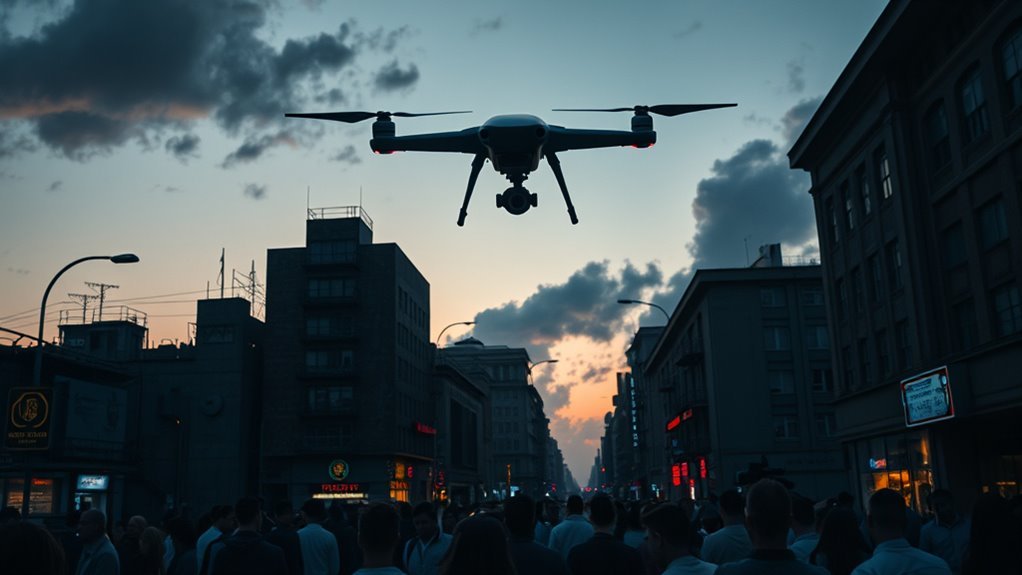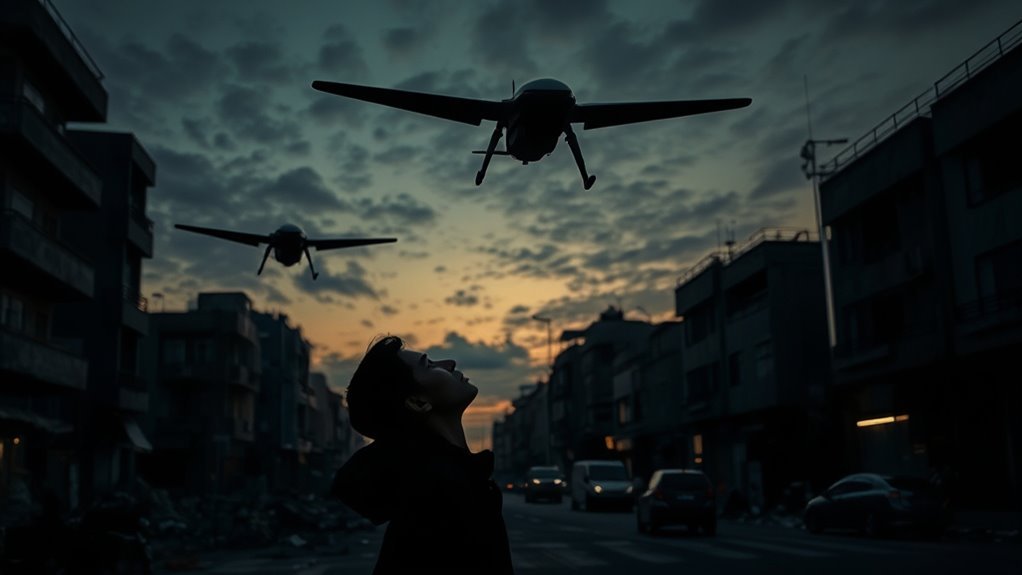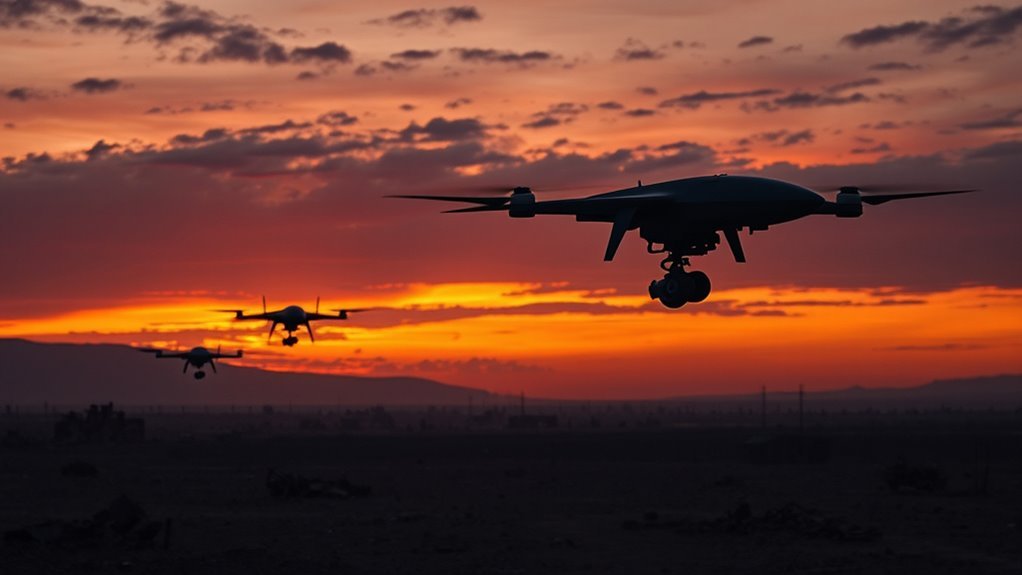The rise of murder drones is largely driven by their cost-effectiveness and advanced technological capabilities. You’ll find that UAVs reduce personnel needs and streamline military operations, making them financially appealing. Their precision in targeting minimizes collateral damage, aligning with modern military strategies that prioritize effectiveness. Additionally, evolving public perceptions about the ethics and safety of autonomous weapons contribute to their acceptance. Discover how these factors reshape the future of warfare and the role of drones.
Cost-Effectiveness of Drone Warfare

While traditional military operations often incur substantial costs regarding personnel and resources, drone warfare presents a more cost-effective alternative. You’ll find that employing unmanned aerial vehicles (UAVs) allows for significant cost reduction in various aspects of military engagement. Drones require fewer personnel, minimizing the need for training, healthcare, and logistical support. This shift not only reduces financial burdens but also enhances operational efficiency. UAVs can be deployed quickly and often at a fraction of the cost of manned aircraft, allowing for precision strikes without extensive resource allocation. By streamlining operations and decreasing the overall financial footprint, drone warfare aligns with the desire for more sustainable military practices, ensuring that resources are used judiciously while maintaining strategic effectiveness. Additionally, the integration of advanced AI in drone technology can further optimize operational workflows and enhance decision-making processes. The use of higher precision in drone capabilities also contributes to more effective targeting and reduced collateral damage during missions.
Technological Advancements in UAV Capabilities

The evolution of unmanned aerial vehicles (UAVs) has been marked by rapid technological advancements, greatly enhancing their operational capabilities. Machine learning and artificial intelligence drive autonomous navigation, allowing drones to execute complex missions with minimal human intervention. Advanced sensors provide real-time data, improving situational awareness and targeting accuracy. Swarm technology enables coordinated actions among multiple drones, amplifying their effectiveness on the battlefield. Miniaturized drones, designed for stealth and agility, offer enhanced endurance for prolonged operations. Advanced stealth features and remote operations further expand operational reach and flexibility. As these technologies converge, UAVs are becoming increasingly integrated into military strategies, fundamentally changing warfare dynamics and setting the stage for a future where such capabilities are not just viable, but essential. Additionally, real-time data transmission supports rapid decision-making, further enhancing operational efficiency during missions.
Increased Demand for Precision and Reduced Collateral Damage

As military operations increasingly prioritize minimizing civilian casualties, the demand for precision-targeted drone strikes has surged. You’ll find that this shift is driven by a need for effective engagement while ensuring civilian safety. The emphasis on precision in military strategy reflects a broader recognition of ethical implications and potential repercussions.
- Enhanced accuracy reduces unintended harm.
- Advanced technology allows for real-time intelligence integration, such as intelligent flight modes that improve targeting accuracy.
- Increased scrutiny on military accountability demands responsible operations.
- The integration of AI-driven autonomy in drone technology enhances operational effectiveness and decision-making in complex scenarios.
These factors contribute to the growing reliance on drones for targeted strikes, aiming to achieve mission objectives with minimal collateral damage. As conflicts evolve, the push for more precise and less destructive methods will likely intensify, shaping the future landscape of military engagements.
Evolving Military Strategies and Tactics
Military operations are increasingly adapting to the complexities of modern warfare, necessitating an evolution in strategies and tactics. With the rise of asymmetric warfare, conventional forces face new challenges from non-state actors employing guerrilla tactics. This shift requires you to reconsider traditional military approaches, integrating advanced technologies like murder drones into counterinsurgency tactics. By utilizing drones, you can enhance surveillance, precision strikes, and operational efficiency in environments where conventional forces might struggle. These tactics allow for targeted engagements, minimizing collateral damage while maximizing effectiveness against elusive threats. Ultimately, the evolution of military strategies will continue to prioritize flexibility and adaptability, making the integration of autonomous systems a crucial component in addressing the challenges posed by asymmetric warfare and insurgency. Furthermore, real-time monitoring capabilities provided by drones can significantly improve situational awareness for military operations. Additionally, the integration of advanced geofencing systems ensures precise operational boundaries, further enhancing mission safety and effectiveness.
Shifts in Public Perception and Acceptance of Autonomous Weapons
Recent surveys indicate that public attitudes toward autonomous weapons, including murder drones, are shifting considerably. As you explore these changes, you’ll notice several key factors influencing public opinion:
- Increased Awareness: As information spreads, people are becoming more informed about the technology behind autonomous weapons. Additionally, the advancement of AI-enhanced obstacle avoidance features is contributing to a greater understanding of how these systems can operate safely.
- Perceived Effectiveness: Many believe that drones can reduce human casualties in combat, making them more acceptable. The incorporation of autonomous navigation innovations allows for more precise targeting and minimizes collateral damage.
- Ethical Considerations: Ongoing debates about the morality of using machines for lethal decisions are reshaping views on their deployment. Furthermore, the incorporation of advanced collision avoidance technology in these systems is expected to enhance safety and reduce unintended harm during operations.
These shifts highlight a complex interplay between technological advancements and societal values. While concerns about ethical implications persist, a growing acceptance of autonomous weapons suggests a significant evolution in how society perceives military force.
Frequently Asked Questions
How Do Murder Drones Affect Ground Troops’ Safety and Effectiveness?
Murder drones greatly impact ground troop effectiveness by increasing the threat level. Without proper drone safety measures, troops face heightened risks, complicating their operations and limiting their ability to maneuver safely in combat environments.
What Ethical Concerns Arise From Using Autonomous Weapons in Warfare?
When you consider autonomous weapons, it’s ironic how they promise efficiency yet raise moral implications and accountability issues. The lack of human oversight complicates ethical warfare, leaving you to ponder the true cost of such advancements.
Can Murder Drones Be Hacked or Misused by Adversaries?
Yes, murder drones can be hacked, exposing hacking vulnerabilities that adversaries could exploit. This misuse aligns with adversarial tactics, potentially leading to unintended consequences in warfare and raising significant ethical concerns regarding autonomous weapon systems.
How Do Civilian Casualties Impact Public Support for Drone Warfare?
Civilian casualties can act like a double-edged sword, cutting through public support for drone warfare. As civilian perception shifts, public outrage often swells, leading to increased scrutiny and demands for accountability in military operations.
What Regulations Exist Regarding the Use of Autonomous Drones in Combat?
You’ll find that autonomous weapon regulations vary globally, with military drone policies often emphasizing accountability and oversight. However, inconsistencies exist, leading to debates on ethical implications and the need for thorough frameworks governing their use in combat.

